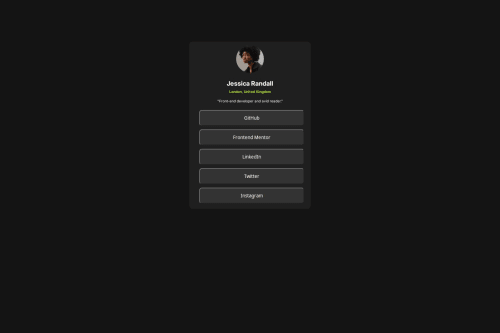Social Links Profile

Solution retrospective
one more project done.
What challenges did you encounter, and how did you overcome them?hover button and change the color of text to black without hovering on the anchor tag itself. solved by .buttons button:hover a{ color: black}
What specific areas of your project would you like help with?my live page is not connecting to the css file. help
Please log in to post a comment
Log in with GitHubCommunity feedback
- @Stroudy
Amazing job with this! You’re making fantastic progress. Here are some small tweaks that might take your solution to the next level…
- I would put these into a
<ul> <li>, and the text should be wrapped with a<a>so it is accessible with a keyboard using the tab key, Using an<a>tag for navigation is semantically correct, improves accessibility for screen readers, and ensures consistent behavior across browsers, unlike a<button>or a<div>not intended for links.
<div class="buttons"> <a href="#"><button type="button"> GitHub</button></a> <a href="#"><button type="button"> Frontend Mentor </button></a> <a href="#"><button type="button"> LinkedIn </button></a> <a href="#"><button type="button"> Twitter </button></a> <a href="#"><button type="button"> Instagram </button></a> </div>-
Developers should avoid using pixels (
px) because they are a fixed size and don't scale well on different devices. Instead, useremorem, which are relative units that adjust based on user settings, making your design more flexible, responsive, and accessible. For more information check out this, Why font-size must NEVER be in pixels or this video by Kevin Powell CSS em and rem explained.- Another great resource for px to rem converter. -
For future project, You could downloading and host your own fonts using
@font-faceimproves website performance by reducing external requests, provides more control over font usage, ensures consistency across browsers, enhances offline availability, and avoids potential issues if third-party font services become unavailable. -
Using
remoremunits in@mediaqueries is better thanpxbecause they are relative units that adapt to user settings, like their preferred font size. This makes your design more responsive and accessible, ensuring it looks good on different devices and respects user preferences.
Great job taking the time to learn! Your efforts are paying off, and I hope these insights guide you to even more success. Keep pushing forward, and remember, you’ve got this! Enjoy your coding adventures! 💪
Marked as helpful - I would put these into a
- @SvitlanaSuslenkova<link rel="stylesheet" href="/assets/css/style.css"> ?
try to add a dot to the path: <link rel="stylesheet" href="./assets/css/style.css">
Marked as helpful - P@MikDra1
If you want to make your card responsive with ease you can use this technique:
.card { width: 90%; max-width: 37.5rem; }On the smaller screens card will be 90% of the parent (here body), but as soon as the card will be 37.5rem (600px) it will lock with this size.
Also to put the card in the center I advise you to use this code snippet:
.container { display: grid; place-items: center; }Hope you found this comment helpful 💗💗💗
Good job and keep going 😁😊😉
Join our Discord community
Join thousands of Frontend Mentor community members taking the challenges, sharing resources, helping each other, and chatting about all things front-end!
Join our Discord